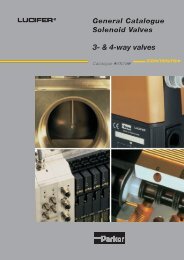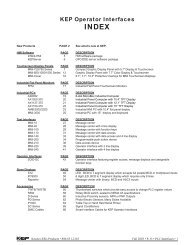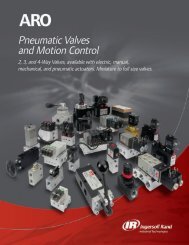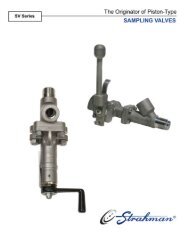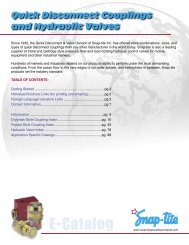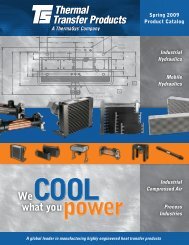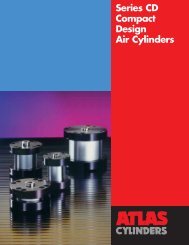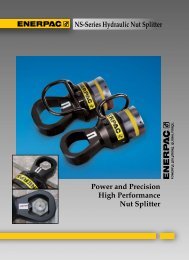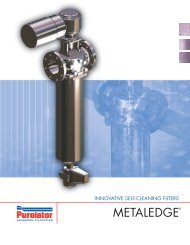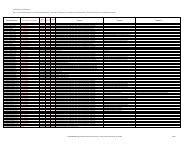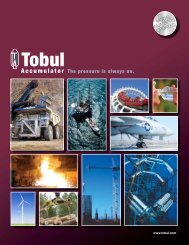Complete Catalog - Norman Equipment Co.
Complete Catalog - Norman Equipment Co.
Complete Catalog - Norman Equipment Co.
You also want an ePaper? Increase the reach of your titles
YUMPU automatically turns print PDFs into web optimized ePapers that Google loves.
END-EFFECTORS<br />
E N D - E F F E C T O R S<br />
S E L E C T I O N P R O C E D U R E<br />
There are three main parameters needed to select the<br />
correct end-effector for a standard application.<br />
• Inside or outside diameter of the work piece<br />
(depending where the work piece will be gripped)<br />
• Depth of the contact area<br />
• Load of the work piece<br />
Other factors must be taken into consideration to<br />
determine if a Firestone AirPicker <br />
or AirGripper endeffector<br />
is suitable for a specific application.<br />
• Texture of the contact surface<br />
• Temperature of the environment<br />
• Chemical compatibility<br />
• Mounting surface dimensions<br />
• Design envelope<br />
These other factors will play a role as individual applications<br />
arise, but the basic design procedure depends<br />
upon the dimensions and load of the object to be<br />
handled. The typical selection procedure is as follows:<br />
1. Using the Selection Guide on page 22, select the<br />
correct AirPicker <br />
or AirGripper end-effector which<br />
inflates to the correct diameter of the object.<br />
2. Determine if the depth of the contact surface is at<br />
least equivalent to the length of the rubber bladder.<br />
If this is not the case, the load capacity will be<br />
reduced and the end-effector may squeeze out the<br />
work piece.<br />
3. Maximum load capacities in the working diameter<br />
range of the end-effectors are shown on the<br />
Selection Guide. The load capacities will vary<br />
depending upon the available air pressure,<br />
contact area, and coefficient of friction. This portion<br />
of the table is given to provide a general idea of<br />
load capacities.<br />
4. After a selection has been made, refer to the<br />
individual data page given on the Selection Guide.<br />
This page will provide detailed information<br />
concerning load capacities, dimensions, inflated<br />
diameter, assembly number, etc.<br />
5. Determine exact inflation pressure required for the<br />
specific application from the Diameter vs Pressure<br />
Curve for lightweight loads, or the Load vs Diameter<br />
Curve for heavier loads.<br />
Determining Required Pressure for Heavy Loads<br />
If the object’s weight is in the range shown on the Load vs<br />
Diameter Curve, refer to those tools to determine the exact<br />
pressure required for the application.<br />
Diameter vs Load Curve<br />
1. Draw a horizontal line intersecting the required load on<br />
the vertical axis.<br />
2. Draw a vertical line intersecting the required work<br />
diameter of the object on the horizontal axis.<br />
3. The intersection point of these two lines should be<br />
near one of the constant pressure curves on the chart.<br />
A rough estimate of the required pressure can be made<br />
in relation to the nearby constant pressure curves.<br />
P045T<br />
I M P E R I A L<br />
P045T metric<br />
M E T R I C<br />
132<br />
Load<br />
lbs.<br />
88<br />
70 PSI<br />
60 PSI<br />
Applicable<br />
Work<br />
Diameter<br />
2.28-3.35"<br />
60<br />
Load<br />
kg.<br />
40<br />
5 BAR<br />
4 BAR<br />
Applicable<br />
Work<br />
Diameter<br />
58-85 mm<br />
45 PSI<br />
3 BAR<br />
44<br />
30 PSI<br />
20<br />
2 BAR<br />
0<br />
15 PSI<br />
1 BAR<br />
The P025 requires 45 psig (3 bar) in order to hold 28 lbs (13 kg) at a 2.1 inch (53 mm) diameter.<br />
18



